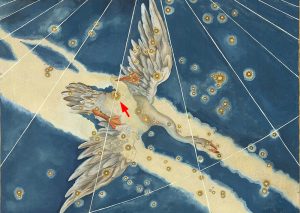Unexpected Variation: The Comet is one of the brightest stars in the sky and has been known for thousands of years. However, it has now managed to surprise astronomers. New observations have revealed that this massive blue supergiant not only constantly changes its brightness, but the polarization of its light also changes irregularly and surprisingly strongly. So far, researchers can only guess why this happens.
The blue supergiant Deneb is hard to miss in the sky: in the summer months it shines as the brightest star in the constellation Cygnus, hence its artistic name Alpha Cygnus. Together with Vega in Lyra and Altair in Adler, it forms the clearly visible Summer Triangle. It is about 300,000 times brighter than the Sun and about 200 times larger in diameter. Our ancestors may have noticed and perhaps even charted this brightest star in the Milky Way as early as the Stone Age.

prototype variable
Deneb is also known for another unusual feature: its brightness fluctuates at different periods, with several periodic fluctuations appearing to be superimposed. Its spectral signature also shows these multi-period changes. They arise partly from rotational oscillations and convection currents in the star's interior, and partly from regional variations in the star's surface density. The blue supergiant is the name given to a whole group of massive, variable stars called Alpha Cygnus stars.
But now astronomers led by Daniel Cotton of the Monterey Institute for Astronomy Research in the United States have discovered another peculiarity of Deneb. In their study, they intensively targeted Alpha Cygni several times between August 2022 and October 2023 using different spectrographs to measure the polarization of its light. In doing so, they followed up on previous observations that had provided contradictory data.
Polarization amplitude fluctuations
The result: Not only is Deneb’s light clearly polarized, but this polarization also exhibits previously undetected fluctuations. The proportion of waves that regularly oscillate at an angle of about 33 degrees is about 4,000 parts per million, Bouton and his team determined. However, depending on the time of observation, this proportion fluctuates by up to about 700 parts per million. “This reveals for the first time that Deneb is also a large-scale polarization variable,” the astronomers say.
As with brightness, the polarization fluctuations do not show a periodic pattern: “There are no clear periods, but fluctuations of several hundred parts per million occur over several weeks,” Cotton and colleagues report. The extent of the deviations is also irregular: “The irregular nature of the variation is also reflected in the fact that one deviation from the mean can be twice as large as the other,” the team explains.
The time course of the now-detected polarization changes could explain why they had not been noticed before: they are too long for typical short-term observations, but too short to be observed in repeated measurements annually, or even over longer periods.
what is the reason?
But what causes these polarization fluctuations, and why are they so irregular? “In general, the broadband linear polarization of a non-magnetic giant star like Deneb arises from electron scattering – either in the photosphere through the distortion of the star or above it through scattering from an asymmetric gas medium,” the astronomers explain. The latter could be caused by bursts of stellar winds of varying strength.
As the astronomers determined, the chronology and only a weak correlation with the brightness fluctuations suggest that the stormy stellar wind is responsible for a large part of the polarization fluctuations. “However, we cannot rule out a weaker signal due to non-radial pulsations,” explain Cotton and his team. Consequently, deformation of the star’s surface, for example due to regional convection currents, could also explain part of the fluctuations.
Astronomers hope that further spectroscopic and optical analyses will provide more information about what causes Deneb’s polarization fluctuations. They want to do this, among other things, using NASA’s TESS space telescope. (The Astrophysical Journal Letters, 2024; doi: 10.3847/2041-8213/ad4b0f)
Source: Astrophysical Journal Letters
July 4, 2024 – Nadia Podpregar

“Subtly charming coffee scholar. General zombie junkie. Introvert. Alcohol nerd. Travel lover. Twitter specialist. Freelance student.”





More Stories
This is what's in the Collector's Edition and this is how much it costs.
Dieter Bohlen reveals the secret to his sparkling white teeth
Intel 800 Series Chipsets without H870-PCH: Detailed table showing (final) specifications.